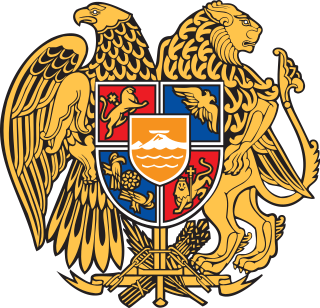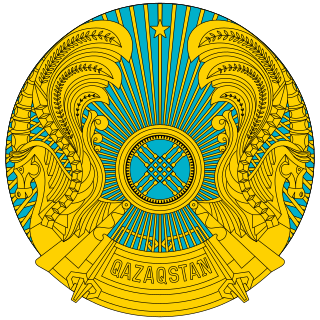
The Government of the Republic of Armenia or the executive branch of the Armenian government is an executive council of government ministers in Armenia. It is one of the three main governmental branches of Armenia and is headed by the Prime Minister of Armenia.

A committee or commission is a body of one or more persons subordinate to a deliberative assembly. A committee is not itself considered to be a form of assembly. Usually, the assembly sends matters into a committee as a way to explore them more fully than would be possible if the assembly itself were considering them. Committees may have different functions and their types of work differ depending on the type of the organization and its needs.

The Eurasian Economic Community was a regional organisation between 2000 and 2014 which aimed for the economic integration of its member states. The organisation originated from the Commonwealth of Independent States (CIS) on 29 March 1996, with the treaty on the establishment of the Eurasian Economic Community signed on 10 October 2000 in Kazakhstan's capital Astana by Presidents Alexander Lukashenko of Belarus, Nursultan Nazarbayev of Kazakhstan, Askar Akayev of Kyrgyzstan, Vladimir Putin of Russia, and Emomali Rahmon of Tajikistan. Uzbekistan joined the community on 7 October 2005, but later withdrew on 16 October 2008.
A parliamentary group, parliamentary caucus or political group is a group consisting of members of different political parties or independent politicians with similar ideologies. Some parliamentary systems allow smaller political parties, who are not numerous enough to form parliamentary groups in their own names, to join with other parties or independent politicians in order to benefit from rights or privileges that are only accorded to formally recognized groups. An electoral alliance, where political parties associate only for elections, is similar to a parliamentary group. A technical group is similar to a parliamentary group but with members of differing ideologies. In contrast, a political faction is a subgroup within a political party and a coalition forms only after elections.

The World Union of Jewish Students is the international, pluralistic, non-partisan umbrella organisation of independent Jewish student groups in 38 countries.

The National Assembly of Armenia, also informally referred to as the Parliament of Armenia is the legislative branch of the government of Armenia.

The Senate of Kazakhstan is the upper house of two chambers in Kazakhstan's legislature, known as the Parliament (Parlamenti). The Senate is composed of elected members: two from each region and two from three municipalities which are Almaty, Astana, and Shymkent.

The Armenian Assembly of America is the largest Washington-based nationwide organization promoting public understanding and awareness of Armenian issues. The organization aims to "strengthen United States/Armenia relations, promote Armenia's democratic development and economic prosperity, and seeks universal affirmation of the Armenian genocide" via "research, education and advocacy."

The Order of Knights of the Hospital of Saint John of Jerusalem, commonly known as the Knights Hospitaller, is a medieval and early modern Catholic military order. It was founded in the Kingdom of Jerusalem in the 12th century and had headquarters there until 1291, thereafter being based in Kolossi Castle in Cyprus (1302–1310), the island of Rhodes (1310–1522), Malta (1530–1798), and Saint Petersburg (1799–1801).

Hastings Gardens is a public garden in Valletta, Malta. It is located on top of St. John's Bastion and St. Michael's Bastion, on the west side of the City Gate. The garden offers views of Floriana, Msida, Sliema, and Manoel Island. Inside the garden is a monument placed by the Hastings family in honor of Francis, Marquis of Hastings, who was a governor of Malta. Lord Hastings died in 1826 and is buried in the garden.

Liesse-Notre-Dame is a commune in the Aisne department in Hauts-de-France in northern France. In the Middle Ages, the village near Laon developed around the cult of the Black Virgin, known as Notre-Dame de Liesse. Pope Pius IX granted the Marian image a decree of canonical coronation on 18 August 1857.
Ukrainian World Congress is a non-profit organization, nonpartisan association, international coordination assembly of all Ukrainian public organizations in diaspora. Originally founded in 1967 as the World Congress of Free Ukrainians, the organization was renamed in 1993 to its current name.

The Ministry of Foreign Affairs of Armenia (MFA) is a state body of executive power, which elaborates and implements the foreign policy of the Government of Armenia and organizes and manages diplomatic services. The MFA acts accordingly to the Constitution and legislation of Armenia. The Ministry of Foreign Affairs coordinates the activities of the executive power bodies of the Republic in the international arena. Since 2021, Ararat Mirzoyan has been the Minister of Foreign Affairs of Armenia.

MIJARC Europe is the European continental branch of MIJARC. It is the platform or umbrella organization, representing the catholic, agricultural and rural youth movements in Europe. It has member movements and contact movements in Portugal (JARC), Spain, France (MRJC), Belgium (KLJ), Germany (KLJB), Hungary (KIM), Austria (KJÖ), Poland (EiR), Bulgaria (YMDRAB), Armenia (FYCA), Georgia (Umbrella), Italy, Malta, the Netherlands, Slovakia (ADEL) and Romania, representing around 150 000 rural young people aged from 12 to 35 years old. At world level, MIJARC represents more than two million young people from Asia, Africa, Latin America and Europe.

The Malta Environment and Planning Authority was the national agency responsible for the environment and planning in Malta. It was established to regulate the environment and planning on the Maltese islands of Malta, Gozo and other small islets of the Maltese archipelago. MEPA was bound to follow the regulations of the Environment Protection Act (2001) and the Development Planning Act (1992) of the Laws of Malta. The national agency was also responsible for the implementation of Directives, Decisions and Regulations under the EU Environmental Acquis as Malta is a member of the European Union, while considering other recommendations and opinion of the Union. The Authority employed over 420 government workers, from a wide range of educational backgrounds, all within their merit of profession.

The Church of Our Lady of Liesse is a church in Valletta, Malta. The church was built in 1740 on the site of a 17th-century church. The cupola was built to the designs of the Maltese Architect Francesco Zammit. The church is located near the shores of the Grand Harbour, close to Lascaris Battery and the site of the fish market. It is especially venerated by the people of the port area.

The European Armenian Federation for Justice and Democracy (EAFJD) is a grassroots umbrella organization which represents a significant part of the Armenian diaspora in Europe. The EAFJD is the main interlocutor promoting Armenian issues in the European Union and other international organizations.

The Assembly of Armenians of Europe (AAE) is a pan-European international organization.




















